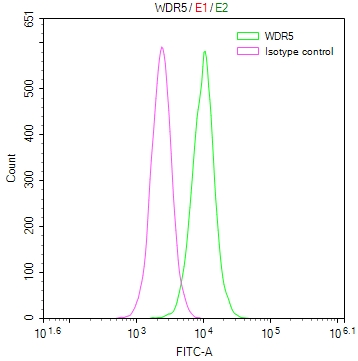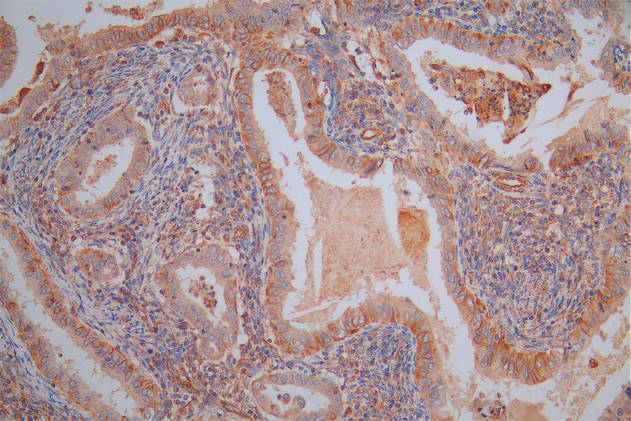CADM1 Antibody
-
中文名稱:CADM1兔多克隆抗體
-
貨號:CSB-PA004340
-
規格:¥1090
-
圖片:
-
其他:
產品詳情
-
Uniprot No.:
-
基因名:
-
別名:BL2 antibody; Cadm1 antibody; CADM1_HUMAN antibody; Cell adhesion molecule 1 antibody; DKFZp686F1789 antibody; IgSF4 antibody; IGSF4A antibody; Immunoglobulin superfamily member 4 antibody; MGC149785 antibody; MGC51880 antibody; NECL-2 antibody; NECL2 antibody; Nectin like 2 antibody; Nectin-like protein 2 antibody; RA175 antibody; SgIGSF antibody; Spermatogenic immunoglobulin superfamily antibody; ST17 antibody; sTSLC 1 antibody; Synaptic cell adhesion molecule antibody; SynCAM antibody; SynCAM1 antibody; TSLC-1 antibody; TSLC1 antibody; Tumor suppressor in lung cancer 1 antibody
-
宿主:Rabbit
-
反應種屬:Human,Mouse
-
免疫原:Synthesized peptide derived from the C-terminal region of Human TSLC1.
-
免疫原種屬:Homo sapiens (Human)
-
標記方式:Non-conjugated
-
抗體亞型:IgG
-
純化方式:The antibody was affinity-purified from rabbit antiserum by affinity-chromatography using epitope-specific immunogen.
-
濃度:It differs from different batches. Please contact us to confirm it.
-
保存緩沖液:Liquid in PBS containing 50% glycerol, 0.5% BSA and 0.02% sodium azide.
-
產品提供形式:Liquid
-
應用范圍:WB, IF, ELISA
-
推薦稀釋比:
Application Recommended Dilution WB 1:500-1:2000 IF 1:200-1:1000 ELISA 1:20000 -
Protocols:
-
儲存條件:Upon receipt, store at -20°C or -80°C. Avoid repeated freeze.
-
貨期:Basically, we can dispatch the products out in 1-3 working days after receiving your orders. Delivery time maybe differs from different purchasing way or location, please kindly consult your local distributors for specific delivery time.
-
用途:For Research Use Only. Not for use in diagnostic or therapeutic procedures.
相關產品
靶點詳情
-
功能:Mediates homophilic cell-cell adhesion in a Ca(2+)-independent manner. Also mediates heterophilic cell-cell adhesion with CADM3 and NECTIN3 in a Ca(2+)-independent manner. Interaction with CRTAM promotes natural killer (NK) cell cytotoxicity and interferon-gamma (IFN-gamma) secretion by CD8+ cells in vitro as well as NK cell-mediated rejection of tumors expressing CADM1 in vivo. In mast cells, may mediate attachment to and promote communication with nerves. CADM1, together with MITF, is essential for development and survival of mast cells in vivo. By interacting with CRTAM and thus promoting the adhesion between CD8+ T-cells and CD8+ dendritic cells, regulates the retention of activated CD8+ T-cell within the draining lymph node. Required for the intestinal retention of intraepithelial CD4+ CD8+ T-cells and, to a lesser extent, intraepithelial and lamina propria CD8+ T-cells and CD4+ T-cells. Interaction with CRTAM promotes the adhesion to gut-associated CD103+ dendritic cells, which may facilitate the expression of gut-homing and adhesion molecules on T-cells and the conversion of CD4+ T-cells into CD4+ CD8+ T-cells. Acts as a synaptic cell adhesion molecule and plays a role in the formation of dendritic spines and in synapse assembly. May be involved in neuronal migration, axon growth, pathfinding, and fasciculation on the axons of differentiating neurons. May play diverse roles in the spermatogenesis including in the adhesion of spermatocytes and spermatids to Sertoli cells and for their normal differentiation into mature spermatozoa. Acts as a tumor suppressor in non-small-cell lung cancer (NSCLC) cells. May contribute to the less invasive phenotypes of lepidic growth tumor cells.
-
基因功能參考文獻:
- miRNA-873 promoted Hepatocellular Carcinoma progression by targeting TSLC1. PMID: 29734164
- High CADM1 expression is associated with KSHV infection. PMID: 29698475
- the immunohistochemical expression of CADM1 has the potential to contribute as an auxiliary tool to the differential diagnosis between nevi and melanomas. PMID: 28843749
- These findings suggest that CADM1 expression is a novel prognostic factor for peripheral T cell lymphoma, not otherwise specified PMID: 28940014
- miR-21 enhances chemo-resistance in tongue cancer cells via directly targeting CADM1, and an inverse correlation between miR-21 and CADM1 expression in vivo. MiR-21 overexpression is attributed to MYCN-mediated transcriptional regulation, which is also predictive for a worse prognosis in tongue cancer PMID: 27055844
- We conclude that CADM1 was not associated with cell-cell interaction between lymphoma cells and macrophages, although CADM1 may be a useful marker of ATLL for diagnostic procedures. PMID: 28420814
- miR-21 overexpression promotes cardiac fibrosis via STAT3 signaling pathway by decrease CADM1 expression, indicating miR-21 as an important signaling molecule for cardiac fibrotic remodeling and atrial fibrillation. PMID: 28335740
- Pathway analysis of the genes associated with the 46 CpG sites revealed an enrichment of immune system process genes, including LYST (cg16962115, FDR = 1.24E-04), CADM1 (cg21933078, FDR = 1.22E-02) and NFATC1 (cg06784563, FDR = 1.46E-02) PMID: 28637314
- CADM1 mRNA expression was highly upregulated in normal tissues compared to esophageal squamous cell carcinoma tissues, indicating that the loss of CADM1 expression influenced the pathogenesis, invasion, and metastasis of ESCC. PMID: 28510248
- Eight and five of the nine samples were negative for cell adhesion molecule 1 and Osterix respectively. The other markers showed no statistical significance(CD151,ALP). osteoblastic differentiation can occur in carcinoma cells and that cell adhesion molecule 1 could be a useful marker for identifying this phenomenon in carcinoma tissues PMID: 28651491
- Our results suggest that, as in the CNS, CADM1 interactions drive exocytic site assembly and promote actin network formation. These results support the broader hypothesis that the effects of cell-cell contact on beta-cell maturation and function are mediated by the same extracellular protein interactions that drive the formation of the presynaptic exocytic machinery. These interactions may be therapeutic targets for re... PMID: 27072493
- High expression of CADM1 on most HTLV-1-infected cells in the face of enhanced cytotoxic T lymphocyte counterselection implies that CADM1 confers a strong benefit on the virus. PMID: 27105228
- Decreased expression of TSLC1 is associated with the differentiation in ovarian epithelial cancer. TSLC1 might be used as a molecular marker of severity in early stage ovarian cancer, and to help differentiating benign and malignant ovarian tumors. PMID: 27146728
- Suppression of tumorigenesis by CADM1 may be mediated by the Rb-E2F1 pathway. PMID: 27298105
- CADM1 prevents squamous cell carcinoma progression by reducing STAT3 activity PMID: 27035095
- Decreased expression of TSLC1 is correlated with the malignancy of non-muscle invasive bladder cancer tissues and low TSLC1 expression may serve as a predictor for bladder cancer recurrence and progression. PMID: 26894268
- CADM1 deletion is associated with neuroblastoma and ganglioneuroma. PMID: 26463893
- Hypermethylation of CADM1 gene may be highly associated with the development of cervical cancer. PMID: 26552048
- Our study showed that miR-126, by down-regulation CADM1, enhances migration and invasion in gastric cancer cells. PMID: 26464628
- This study revealed that Merkel cell polyomavirus -negative Merkel cell carcinomas significantly expressed higher CADM1 and lower MAL than Merkel cell polyomavirus -positive Merkel cell carcinomas PMID: 26772392
- CADM1/MAL methylation increases with severity of cervical intraepithelial neoplasia PMID: 26219541
- SynCAM1 delineates the postsynaptic perimeter of the synaptic cleft as determined by immunoelectron microscopy. PMID: 26687224
- increased CADM1 shedding appeared to contribute to the development of emphysema by generating alphaCTF and the ICD in lung epithelial cells. PMID: 26259600
- CADM1 shedding is increased in idiopathic interstitial pneumonia and contributes to alveolar epithelial cell apoptosis. PMID: 26231557
- Results show that CADM1 is downregulated in HPV-positive cervical cancers and that epigenetic alteration of CADM1 was more frequent in this type of cancer. The restoration of CADM1 expression may be a potential strategy for cervical cancer therapy. PMID: 25845528
- The use of CADM1, MAL, and MIR124-2 as biomarkers for full molecular screening in HIV infected women who are also positive for human papillomavirus. PMID: 26473640
- CADM1 induction was repressed in primary samples from AML patients at relapse. PMID: 25491945
- Our study reveals a novel mechanism of chronic NF-kappaB activation by CADM1 in HTLV-1 infected cells PMID: 25774694
- Trans-homophilic interaction of CADM1 activates PI3K by forming a complex with MAGuK-family proteins MPP3 and Dlg. PMID: 25268382
- In the absence of SynCAMs, selective axon-axon interactions are perturbed resulting in aberrant pathfinding of sensory axons. PMID: 25335893
- Increased ectodomain shedding of cell adhesion molecule 1 from pancreatic islets in type 2 diabetic pancreata. PMID: 24964098
- In a population-based association study, we confirm a role for CADM1 variants in increasing the risk of VT by interaction with protein C pathway abnormalities. PMID: 25306186
- The significant association of IGSF4 with HPV-positive head and neck squamous cell carcinoma suggests that HPV-positive tumors are to a greater extent driven by promoter hypermethylation in this tumor suppressor gene. PMID: 25569158
- HPV-positive oropharyngeal squamous cell carcinoma is associated with TIMP3 and CADM1 promoter hypermethylation. PMID: 25065733
- CADM1/TSLC1 is an antiinvasive gene, the overexpression of which inhibits the invasion of A375 cells. PMID: 25215547
- Cytology and bi-marker CADM1/MAL-methylation analysis perform complementary for CIN2+/CIN3+ detection when used as triage tool on cervical scrapes of HPV positive women. PMID: 25667975
- TSLC1-AS1 was a tumor suppressor of glioma and a mediator of TSLC1 expression. PMID: 25031725
- The study showed that CADM1 is a direct target of miR-1246 leading to its down regulation in hepatocellular carcinoma cells. PMID: 25159494
- DNA methylation analysis of CADM1, MAL and miR124-2 in cervical scrapes consistently detects cervical cancer PMID: 25281766
- Loss of CADM1 expression is an independent prognostic factor especially associated with the development of brain metastases in breast cancer patients. PMID: 24833255
- We showed that the CADM1 versus CD7 plot is capable of discriminating clonally expanding HTLV-I-infected cells in indolent and acute-type T-cell leukemia-lymphomas and in asymptomatic carriers PMID: 24727323
- MPP3 and Dlg, membrane-associated guanylate kinase homologs (MAGuK) proteins, connect CADM1 with p85 of PI3K by forming a multi-protein complex at the periphery of cells. PMID: 24503895
- Data suggest that cell adhesion molecule 1 (CADM1) is a key adhesion receptor, which regulates mast cells (MCs) net adhesion. PMID: 24465823
- TGF-beta upregulates miR-182 expression to promote gallbladder cancer metastasis by targeting CADM1. PMID: 24445397
- CADM1 ectodomain shedding appeared to cause alveolar cell apoptosis in emphysematous lungs by producing alphaCTF that accumulated in mitochondria. PMID: 24092566
- The paper shows that CADM1 regulates mast cell net adhesion, both directly through CADM1-dependent adhesion, and indirectly through the regulation of other adhesion receptors. The latter is likely to occur via docking of KIT and polymerization of cortical F-actin. CADM1 is involved in docking of KIT to the cell surface and phosphotyrisine signaling, and polymerization of cortical F-actin. PMID: 24465823
- SynCAM, a novel putative tumor suppressor, suppresses growth and invasiveness of glioblastoma. PMID: 23907434
- Infection of NCI-H460, A549, and H1299 lung cancer cells with Ad.sp-E1A(Delta24)-TSLC1 induced apoptosis. PMID: 23503473
- Data suggest that tumor suppressor in lung cancer 1 (TSLC1) as tumor suppressor may play prominent roles in development and progression of cutaneous squamous cell carcinoma (CSCC) via regulation of different biological processes. PMID: 23812766
- The cell adhesion molecule Necl-2 competitively binds the immune receptor CRTAM. PMID: 23871486
顯示更多
收起更多
-
亞細胞定位:Cell membrane; Single-pass type I membrane protein. Cell junction, synapse.
-
蛋白家族:Nectin family
-
數據庫鏈接:
Most popular with customers
-
-
YWHAB Recombinant Monoclonal Antibody
Applications: ELISA, WB, IHC, IF, FC
Species Reactivity: Human, Mouse, Rat
-
Phospho-YAP1 (S127) Recombinant Monoclonal Antibody
Applications: ELISA, WB, IHC
Species Reactivity: Human
-
-
-
-
-





















